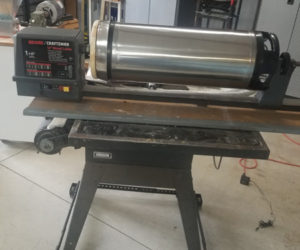Kegerator Tower Cooling: An alternative chilling system
I’m proud to say that as of 2021, I’ve been brewing for twenty years. I spent the first decade of those years producing kits and bottling in flip tops. I read about all-grain brewing processes for longer than I’d care to admit prior to moving away from extract kits. Once I attended my first homebrew club meeting I made the jump to all-grain. Tired of washing bottles and bottling, I promptly made the jump to kegging and haven’t looked back. Bottling is still my least favorite brewing-related activity. I installed my first kegerator in 2014 (pictured below), as an under-counter install. Keeping the tower cool was a challenge, since this kegerator didn’t have anything in place to do so. Relying only on convection led to many a foamy first beer dispense. I put my engineer brain to work to ponder several options.

Several were recently published in the November 2020 BYO “Advanced Brewing” column; two options mentioned are having a forced air fan, and a glycerol (glycol) recirculating pump. I’m here to tell you there’s another option that is easy to build, inexpensive, and solid state. I built a copper pipe heat sink that keeps my beer lines and tap faucets chilled. The copper wire and pipes conduct heat away from the tower and taps to the fridge’s chilling system. From there the heat is transferred to the refrigerant system. I’ve been through three iterations to get to what I’m presenting here. Each has improved on the last in terms of cooling capability and results.
Copper has a high heat transfer coefficient, and we’ll be using that physical property to our advantage. See the following table for the thermal conductivity of other materials. Given the ubiquity of copper in plumbing and wiring, it’s an ideal choice for this project. Over the many years my heat sinks have been in operation, I have yet to observe any corrosion of the copper despite the moisture often present on the fridge surfaces. I credit the low temperatures slowing the oxidation reaction.

There are a few things to keep in mind when starting a project like this. First, you want the mass of the cold side (attached to the fridge evaporator) to be larger than that of the warm side (up the tower). This will help ensure the net movement of heat away from your faucets. The second is to allow room for all of your tap lines. In this project I only have two 5-mm ID (3⁄16-in.) vinyl lines, so the inner diameter of a 1-in. trade-size copper pipe allows them to fit nicely. Note that they don’t fit with the compression fittings on, so plan accordingly.
Tools and Materials
- Kegerator with tower-
- mounted faucets
- 5 ft. (1.5 m) ½-in. copper pipe
- 6 in. (40 cm) 1-in. copper pipe
- (5) ½-in. copper elbows
- (1) ½-in. copper tee
- (1) 1-in. to ½-in. branched tee
- Zip ties
- Zip tie mounts
- 12 in. (30 cm) 14-gauge
- copper wire



